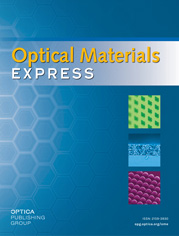Optical Materials Express Feature Issue
Polaritons in Mesoscale Structures and Quantum Materials
Submissions Open: 1 January 2025
Submission Deadline: 1 March 2025
Quantum materials with non-classical electronic and optical properties may enable new devices for quantum information science and technologies. When materials are hybridized with light fields through strong light-matter interaction, the information exchange between electrons and photons becomes more efficient, and the electronic interaction itself can be modified by the presence of real and virtual photons. These engineered "polaritonic materials" may have an impact on electronic applications where material properties are conventionally thought to be intrinsic.
This feature issue will highlight recent advances and perspectives on the future of light-matter interaction in a broad range of mesoscale structures and quantum materials, as well as the potential to use such interactions to study and/or alter amaterial’s properties. It will connect three rapidly advancing disciplines: the design and implementation of nanophotonic and metamaterials with enhanced light-matter coupling; bosonic excitations in correlated electronic, magnetic, and low-dimensional materials; and micro- and spectroscopic characterization techniques to reveal new properties of materials. We welcome submissions focusing on polaritons in more classical systems with well-defined strong coupling, as well as new complex systems near the transition between weak and strong coupling regimes, that help to define the future direction and possible boundaries of the field.
Topics to be covered include but are not limited to:
- Phonon polaritonic materials and structures
- Anisotropic and hyperbolic polaritonic materials, e.g., hBN and MoO3
- Plasmon polaritons in correlated electronic materials, e.g., few-layer graphene and Moiré superlattices
- Exciton polaritons and devices with spin and/or orbit selectivity, e.g., transition metal dichalcogenide semiconductors and black phosphorus
- Magnon polaritonic theories and experiments
- Polaritonic devices, functionalities, and applications, such as metasurfaces, sub-wavelength photonics, optical sensing, lasers, all-optical switches, polariton transistors, etc.
- Tunable polaritonic devices in low-dimensional materials, e.g. by strain and electrostatic gating
- Photonic devices in ultrabroad spectral range enabled by polaritons, e.g., terahertz, mid-infrared, and ultraviolet frequencies
- Quantum information carried by polaritons
- Hybrid bosonic excitations in quantum materials
- Strong light-matter interaction of single two-level systems and single molecules
- Light-matter interaction in strongly anharmonic systems
- Transition from weak to strong or ultrastrong coupling regime in optical materials
- Physical and chemical properties of materials modified by polaritons
Manuscripts must be prepared according to the usual guidelines for submission to Optical Materials Express and must be submitted online through the Prism submission system. When submitting, authors should specify that the manuscript is for the "Polaritons in Mesoscale Structures and Quantum Materials" feature issue (choose from the drop-down menu).
Feature Issue Guest Editors:
Hanyu Zhu, Rice University, USA (Lead Editor)
Siyuan Dai, Auburn University, USA
Xiaoze Liu, Wuhan University, China
Iris Niehues, CIC nanoGUNE, Spain
Alexander Paarmann, Fritz Haber Institute, Germany

